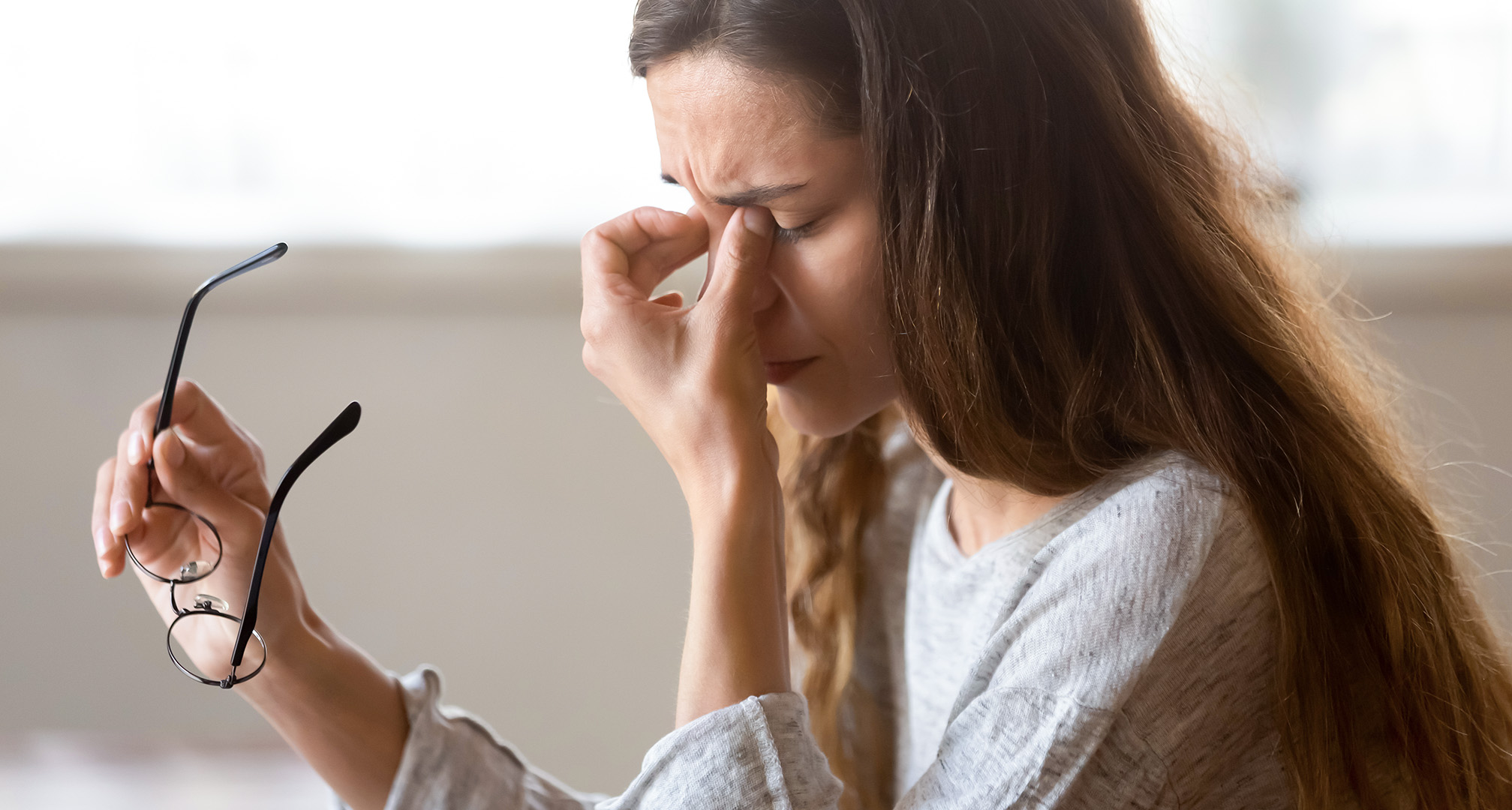Eye twitching: Causes & how to stop it

Table of contents
What is eye twitch
Eye twitching is an involuntary muscle contraction of the eyelid muscles in the right eye or left eye. It generally involves only one eye at a time. It can affect both the upper and lower eyelids. Only very rarely does the twitch involve both eyes at the same time.
This condition is also known as myokymia, blepharospasm, false fibrillations or eyelid myoclonias.
Keep reading to know more about the different types of eye twitching, the most common causes, and get advice from the Lentiamo experts.
How normal is eye twitching?
Most of the time eyelid twitching is harmless. It's not usually a sign of anything serious or a medical issue. Eye twitching or mild eyelid spasms are very common and happen to most people at some point.
Generally, it is a temporary discomfort that does not necessitate medical intervention. However, in some cases, it may be associated with eye conditions like conjunctivitis, blepharitis, glaucoma, or corneal abrasions. In rare instances, it can indicate more serious ailments such as multiple sclerosis, epilepsy, Parkinson's, Alzheimer's, viral encephalitis, or exposure to toxic substances. Fortunately, such occurrences are infrequent.
Types of eye twitches
Myokymia — persistent and subtle spasms that primarily impact the lower eyelid. It’s the most common type of eye twitching. It is typically temporary and goes away without treatments.
Benign essential blepharospasm — characterised by the occurrence of abnormal blinking or spasms of the eyelids. Typically, this condition manifests bilaterally. It is a rare neurological disorder.
Hemifacial spasm — a neuromuscular disorder that manifests as recurrent and involuntary contractions of the facial muscles on one side of the face. This is a more serious condition that may require medical attention.
Symptoms associated with eye twitching
Common symptoms are repetitive blinking, a sensation of a pulsating pupil, twitching, or fluttering of the eyelid of the left eye or right eye. Sometimes the discomfort is also accompanied by blurred vision, sensation of a foreign body in the eye, light sensitivity, and eye irritation.

Common symptoms of eye twitching include:
- Foreign body sensation in the eye
- Eye fatigue
- Lacrimation
- Dry eye
- Red eye
- Blurred vision
- Decreased visual acuity
- Photophobia
- Ocular tension or pain.
Why is my eye twitching?
Eye twitching and eyelid twitching are typically idiopathic, which means they are temporary disorders of unknown origin. There are, however, a few common triggers that are quite often associated with eye twitching. Stress is the most frequent cause, as the body seeks to manage nerve tension. Vitamin B12, potassium and magnesium deficiency are also frequently connected with eye twitching. When we lack these substances, we are more likely to experience muscular spasms, cramping in various parts of the body and tiredness.
Common causes of eye twitching:
- Poorly managed psychophysical stress
- Vision impairments when not properly corrected
- Excessive eye fatigue or eye strain
- Lack of sleep or long periods of insomnia
- Prolonged use of certain medications
- Pollution, wind
- Poor diet and nutritional deficiencies
- Dry eyes, sometimes related to contact lenses
- Abuse of caffeine, smoking, alcohol and other stimulants
- Corneal irritation, recent conjunctivitis, allergies
How to stop eye twitching?
Normally, identifying and eliminating the causes of eye twitching, or getting rid of some bad habits, is enough to get rid of this annoying discomfort.
Rest for the eye
Eye strain is a major cause of trembling eyelids. Avoid spending too much time in front of digital screens, and take breaks every 20 minutes to rest your eyesight. Wearing blue light glasses can also help in reducing eye strain. If reading takes too much effort, it could be because your prescription needs to be updated. Last but not least, remember to wear sunglasses when you spend time outdoors, as UV rays can also cause eye strain.
Stress management and better sleep
Stress and tiredness are often the cause of eye twitching. Improving sleep quality and quantity, slowing down the pace of your day-to-day routine or engaging in practices such as meditation, yoga, and other relaxation techniques has been found to be effective.
Healthier diet
Consuming less caffeine, alcohol and other stimulants can help against eye twitching. These substances can over-excite the nervous system and thus trigger eyelid spasms. Fruit, nuts, and vegetables are excellent sources of vitamins and minerals. A greater intake of vitamin B12, magnesium, potassium, and omega-3 can help reduce inflammation and muscle tension. If eating healthier foods is not enough, your doctor can prescribe suitable supplements that will help against possible deficiencies.
Eye exercises and massage
As eye twitching is often caused by muscle tension, a good method is to devote a few minutes a day to do eye exercises and massages. You can try the following routine in its entirety, or only some of the steps described below.
- Warm-up: Begin by rubbing your palms together vigorously until they feel warm. Then, gently place your warm palms over your closed eyes, allowing the heat to penetrate. This warm-up technique helps relax the eye muscles and prepares them for the subsequent exercises.
- Blinking: This helps lubricate the eyes and reduce dryness. Sit comfortably and blink rapidly for 20 seconds, ensuring your eyes close fully with each blink. Follow this by keeping your eyes closed for 20 seconds, allowing them to rest.
- Eye rolling: Improves eye muscle flexibility and enhances blood circulation. Start by looking straight ahead and slowly roll your eyes in a clockwise direction. Complete a full circle, then reverse the direction and roll your eyes counterclockwise.
- Focus shifting: Aids in enhancing eye coordination and flexibility. Choose an object at arm's length and focus on it for a few seconds. Then, shift your gaze to an object in the distance, allowing your eyes to adjust. Alternate between the near and distant objects, focusing on each for a few seconds.
- Massage: Useful to release muscle tension, improve blood circulation, and promote relaxation. Massage the temples with circular motions, or use your fingertips to massage delicately from the sides of your nose towards the temples.
Hydration for eyes and body
Maintaining appropriate hydration can also alleviate eye twitching. Lubricating eye drops can be applied to alleviate dry eyes. There are also specific eye drops that you can use with contact lenses. And don’t forget that drinking more water during the day will help both against dry eye and eye twitching.
When to visit a doctor
Eye twitching becomes a serious issue only rarely. If you wonder when to worry about your eye twitching, there is no definite answer. Doctors agree that it can be worth it to go for a check-up if the discomfort persists with abundant frequency for more than one month or if it involves both eyes at the same time.
Other symptoms to watch are: if the regular light spasms are often accompanied by other signs, such as tremors in other parts of the face or body. Drooping eyelid or complete closure of the eyelid, as well as persistent swelling or abnormal discharges.
Experiencing these symptoms doesn’t necessarily mean that there is a serious issue, but it’s advisable to consult an eye doctor for appropriate testing and diagnosis. A specialist can make a diagnosis during the eye exam.
Closing thoughts by Lentiamo’s optometrist
Lentiamo’s specialist Eliška Malinová, Bc. shares her observations about this issue:
In my practice as an optometrist, I've come to recognize that eye myokymia, or eye twitching, is a shared experience that transcends backgrounds and ages. It's a reminder that our eyes can reflect the stresses and strains of our lives. My advice to patients with this problem is: make sure you get enough quality sleep, follow drinking regime, supplement essential vitamins and minerals to your body and try to reduce your stress levels. In case you work all day with a computer or mobile devices, get protective glasses with a filter against blue light. Usually, this problem will go away on its own after a few days to weeks. If the problem persists for more than 1 month, see your eye doctor.
Sources
1. Brigham and Women’s Hospital, Eye Twitching
2. National Library of Medicine, Eyelid Myokymia








Comments